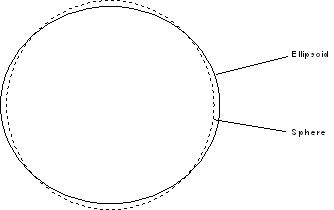
For maps of the Earth where accuracy is not of particular concern, we can safely assume that the Earth is perfectly spherical in shape. However, the Earth is actually somewhat ellipsoidal (or egg-shaped), approximately 1/300th wider than it is tall, assuming a vertical orientation with respect to the axis of rotation. This shape needs to be taken into account to produce maps of any significant accuracy.

This is an example of an ellipsoid (solid line) superimposed on a sphere (dashed line).
While an ellipsoid is a closer approximation of the Earth's shape than a sphere, the Earth's surface is not entirely uniform in curvature, so any ellipsoidal representation of the Earth is still only an approximation. This being the case, cartographers have historically used a number of slightly different ellipsoidal representations in attempts to produce more accurate maps of different regions of the Earth.
You can define the ellipsoids with Map | Convert Projection. Select a projection (other than State Plane 1927, State Plane 1983, Universal Transverse Mercator, or Unprojected Latitude/Longitude) then click the Settings button to access the ellipsoid options.
Ellipsoid Definition
You can choose an ellipsoid type from the Ellipsoid list. If you select User Defined, set the next three parameters in the Ellipsoid definition group box. The Major axis should be set in meters. Next, you can set either the Minor axis in meters or the Flattening ratio in meters. If you do not understand ellipsoids and datum definitions, please use the defaults. For more information on these subjects, see the references provided.
See Also
Introduction to Map Projections
Characteristics of Projections
Latitude/Longitude Coordinates
Latitude/Longitude in Decimal Degrees
Using Scaling to Minimize Distortion on Latitude/Longitude Maps